Antenna Information and Mounting Guide
Brief Antenna Introduction
There are many different of antennas available to purchase that can connect to your Wireless Networking equipment to increase performance in certain situations. Each type of antenna is designed with a specific use in mind and will perform extremely different when compared to another so choosing the correct type for your application is critical in maximising the potential of your wireless network. For example, an enterprise trying to bridge two office networks in buildings across town is going have different requirements for its wireless network than a single user trying to create a roam-able network within their home office and different the same antenna type cannot suit both.
Benefits of Utilising Antennas
For wireless networking, an external antenna may serve as a significant signal quality and strength booster that can enable you to increase the performance of your network within a predetermined coverage area, or extend the range of your existing network so that an acceptable level of performance can be gained at much further distances. Antennas work by reducing the area of radiation of the signal transmitted by the wireless networking device by stopping it from radiating outwards, evenly in all directions (imagine a sphere); instead focusing it in a certain direction. This focusing does not have to be within the shape of a narrow beam but can be in many different ways depending on the type of antenna used. For example, an Omnidirectional antenna almost completely stops signal radiation on the vertical plane so you get disc-like shaped coverage whereas a sector antenna radiates a wide angle, fan shaped coverage area.
Applications of Various Antennas
For applications where you want to provide an even and wide coverage area on one plane, such as across open public area such as a seating area maybe in an airport or train station, an Omnidirectional antenna will almost always provide the best network connection as they transmit in every direction except for above or below (assuming it is mounted vertically). You would want to mount this antenna in the centre of the coverage area as it radiates outwards evenly and if you required connection slightly above or below the antenna a low gain (dBi) would be necessary.
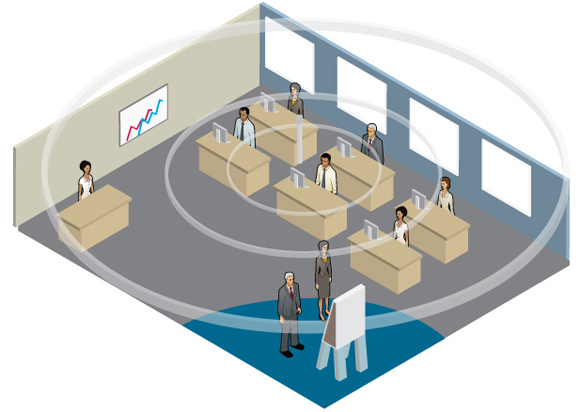
In situations where you want to provide a wide coverage area in only one direction a sector antenna can be utilised very efficiently. Sector antennas have a radiation pattern on only one side of the antenna and typically have wide beam widths of between 90 and 180 degrees. These can be ideal for applications where you required a strong signal in a local area with the ability to locate the antenna in a corner of the coverage area; such as a corner of a large office floor where the antenna can be mounted high up on the ceiling in the corner of the room titled downwards to provide coverage to all employees within their booths.
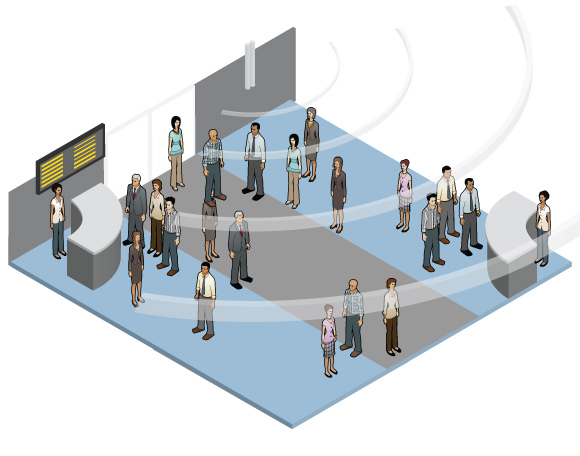
Unlike applications where a large coverage area is required, highly directional antennas can be used in situations where a network is required to perform highly across further distances to connect to one other location. Directional antennas are typically used for Point-to-Point Bridges or Point-to-Multipoint networks where high gain units will be located on both ends of the links to produce a very narrow beam of signal that can travel a lot further without loss of signal strength. A Grid or Flat Panel antenna can provide good, high gain signals with reduced beam widths with large Dish antennas producing a very intense, focused beam that can typically travel many kilometres.
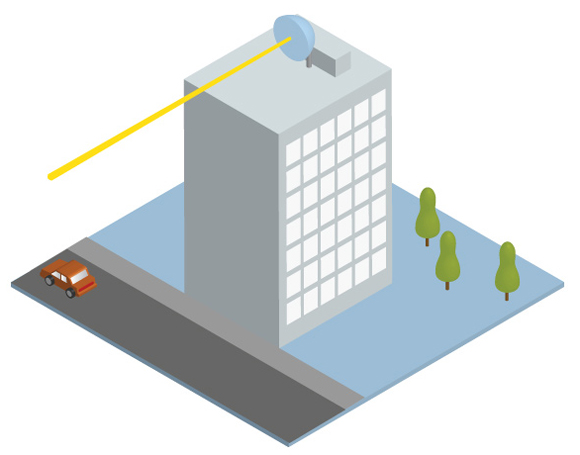
As mentioned above, there are lots of types of antennas and each application has at least one type of antenna intended for it and it is important to remember that the more gain the antenna has, the stronger the signal it radiates but the less coverage area it will give. The right choice of antenna is critical and a poor decision in the antenna type used on your network could severely hamper performance.
Please note:
Gain is value stated in dBi and represents the ratio of the intensity of the radiation in a particular direction by the antenna compared to if it radiated the signal evenly in all directions. When an antenna receives or transmits signal, it is focused in a certain direction or plane and that reduction in coverage area by intensifying it in a reduced area is the gain.
dBi (Decibels Isotropic) is a measurement of the gain of an antenna in a particular direction relative to an isotropic radiator (equal radiation in every direction) where the larger the value stated, the greater the gain. These are usually given for antennas designed to operate at frequencies greater than 1GHz.
Antenna Types
A breakdown of the types of antennas that are typically available for Wireless Networking and specific information about each is listed below:
Omnidirectional Antenna
An external antenna that radiates signal in evenly in almost 2 dimensions only, much like a circle pattern with a slightly protruding top and underside with increasing depth the further you are away from the signal source in much the same way as a lighthouse beam would appear if shining in all directions. They are particularly useful for use in areas where you want to supply network access to a large, local area on the same vertical height such as a HotSpot in a public park. A medium gain Omnidirectional antenna (around 10 dBi) can transmit good quality signals over a kilometre or two providing that the coverage area is free of obstruction and the receiving end has a medium gain antenna (roughly 8 dBi).
Characteristics:
- Low to medium gain (dBi) ratings
- Wide coverage area on horizontal plane
- Minimal vertical plane coverage
- Donut/ring shaped coverage area
- Short to medium range
Beamspread:
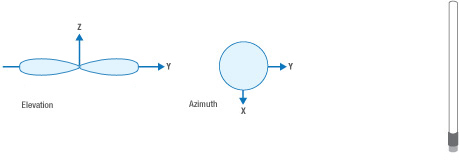
Sector Antenna
A Sector antenna's form gives it a fan-shaped radiation pattern, wide in the horizontal direction and relatively narrow in the vertical direction. Typical antennas used can have as much as around 60° - 150°+ of horizontal beamwidth with a vertical beamwidth not wider than 15° or so. They are usually mounted high with a downward beam tilt or downtilt so that the base station can more effectively cover its immediate area and not cause RF interference to distant cells. These can be useful in areas such as a very large office room where one sector antenna mounted high, in a corner could provide the whole room with network access whereas an Omni antennas signal would be disrupted by complex work booth layout. Sector antennas seem to be quite efficient when compared to Omni antennas as they only radiate signal one side of the antenna and because of this, they can transmit signal further or provide strong signal within the same coverage area for the same gain rating.
Characteristics:
- Medium gain (dBi) ratings
- Wide coverage area on horizontal plane in forward direction
- Some vertical plane coverage
- Traditional Japanese hand fan shaped coverage area
- Short to medium range
Beamspread:

Flat Panel Antenna
So called because they look like flat panels, these antennas can provide relatively high gain figures whilst being physically smaller or low profile suited for areas where there is a lack of space or aesthetic quality of the installation area must be maintained. Due to their high gain capabilities, Flat Panel Antennas can be used for longer links whilst still giving a relatively wide beamwidth when compared to a dish or grid, because of this, they are ideal for networks that are intended to look at distant Omni antennas or need to give coverage to subscribers over a larger area at long distances. Patch antennas effectively act as a smaller Flat Panel antenna giving a larger beamwidth.
Characteristics:
- Medium to high gain (dBi) ratings
- Moderate coverage area on horizontal plane
- Moderate coverage area on vertical plane
- Conical shaped coverage area
- Medium to long range
Beamspread:

Grid Antenna
Grid antennas are much like the parabolic dish antennas but the permeable grid design lets wind and snow pass through whilst leaving your wireless communications undisturbed and still being highly directional. They offer very high gain values that allow networks to be linked over vast distances but the beamwidths are therefore very small therefore, typically, only allowing connection between two devices. They are ideal for long distance, Point-to-Point applications where adverse weather where a dish would be badly affected.
Characteristics:
- High to very high gain (dBi) ratings
- Low coverage area on horizontal plane
- Low coverage area on vertical plane
- Very narrow, conical shaped coverage area
- Long to very long range
Beamspread:

Dish Antenna
A Dish antenna is your conventional, concave, parabolic shaped antenna that reflects signal onto a transmitter or receiver located in front of the dish at the focal point. Dish antennas typically have very high gain values by focusing the signal into a very narrow beam allowing high performance links to be achieved over vast distances over tens of kilometres whilst not interfering with other networks due to the lack of signal over spread. As they act as large wind buffers, Dish antennas need to be securely mounted to avoid damage or misalignment in high wind conditions. They are perfect for Point-to-Point applications requiring a link over massive distances or even shorter links that where maximum performance potential is realised.
Characteristics:
- High to very high gain (dBi) ratings
- Low coverage area on horizontal plane
- Low coverage area on vertical plane
- Very narrow, conical shaped coverage area
- Long to extremely long range
Beamspread:

Mounting and Installation
Mounting Types
Antenna mounts and mounts for devices with integrated antennas come in various forms giving the mountable device more possibility to be located in different areas for best performance. Some are, wall mounts that allow the antenna or device to be positioned on a building wall, pole mounts that allow for the unit to be secured to a pole or mast which can locate the antenna high up, floor based stands such as a tripod allowing for deployment in areas such as rooftops and finally window mounts that utilise suction pads to adhere to glass.
Mounting Methods
A secure and solid, well mounted antenna installation is a key factor in achieving a well performing Wireless Networking link. When mounted outdoors, an external antenna is subject to the harsh weather conditions of the environment that can cause brackets and fastenings to become loose and water to enter the electrical circuits. Therefore, when installing outdoor antennas (and also any outdoor devices), careful attention needs to be made to waterproof any connections with sealant or self amalgamating waterproof tape and making sure that the mount is stable and secure to avoid any misalignment occurring in high wind situations. Damage to connectors can also cause signal losses due to impedance changes which will lower the performance of the network.
Line of Sight
Line of Sight is represented by clear signal path between both Wireless Networking devices and is a vital characteristic for high performing, long distance links. This can be affected when objects intrude on the 1st Fresnel Zone and this can have a dramatic impact on availability and performance. Note that a clear optical line of sight does not mean a clear line of sight for networking antennas. For more information, please refer to our "Fresnel Zones" article.
Alignment
Alignment is also critical to the operation of antennas. They should almost always be aligned to centre of the signal path and angle whilst also being orientated on the same level plane.
Cable Routing
Low Loss Co-Axial cable should be used to connect the antenna to your device. Be careful when handling Coax cable as twisting it or bending it can damage the cable. If necessary, use a flexible Pig-Tail cable to travel the final part to connect to your antenna or device if the cable needs to twist or bend in this area. Also note that your cables should take the shortest possible path to connect devices and should definitely not coil or wrap around poles as any loops in the cable cause interference which can significantly affect performance. You can also utilise a technique called drip looping at cable ends where connections occur. This technique employs a practice where you run a U shaped loop pointing downwards just before the connection is made to ensure that any water running down the cable does not flow onto the connector and instead drips off the cable below. When using outdoor devices, bottom cable entry is recommended versus side entry. Never run the cable in through the top of your device enclosure. For more information on Low Loss RF Co-Axial Cables, please refer to our "Wireless Networking Cables Guide" article.
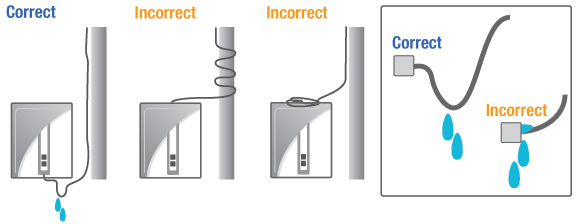
Lightning
Outdoor mountings such as antennas can also be sensitive to lightning strikes that can damage not only the device that is struck but also any other devices that are connected on the LAN. Lightning Arrestors should be place in between the antenna and wireless networking device and surge protector sockets used for any devices connected to the network.
In summary, when mounting an antenna, keep in mind the following factors:
- Choose the correct antenna type and gain to suit your application.
- Make sure that your mounting is secure to handle high wind, avoiding damage and misalignment.
- Waterproof all your devices to avoid damage to electrical circuits.
- Align your antenna properly trying to achieve a mounting position giving a clear Line of Sight with an empty 1st Fresnel Zone.
- Route your Co-Axial cable well avoiding coils, loops and areas where water can run onto connectors.
For further reading, please refer to our "Fresnel Zones" and "Path Loss, Link Budget and System Operating Margin" articles to see how antenna type, gain and location ties into the overall performance of your Wireless Networking link.